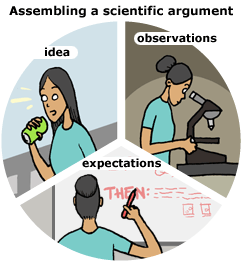Taken together, the expectations generated by a scientific idea and the actual observations relevant to those expectations form what we’ll call a scientific argument. This is a bit like an argument in a court case — a logical description of what we think and why we think it. A scientific argument uses evidence to make a case for whether a scientific idea is accurate or inaccurate. For example, the idea that illness in new mothers can be caused by doctors’ dirty hands generates the expectation that illness rates should go down when doctors are required to wash their hands before attending births. When this test was actually performed in the 1800s, the results matched the expectations, forming a strong scientific argument in support of the idea — and hand-washing!

 Though the elements of a scientific argument (scientific idea, expectations generated by the idea, and relevant observations) are always related in the same logical way, in terms of the process of science, those elements may be assembled in different orders. Sometimes the idea comes first and then scientists go looking for the observations that bear on it. Sometimes the observations are made first, and they suggest a particular idea. Sometimes the idea and the observations are already out there, and someone comes along later and figures out that the two might be related to one another.
Though the elements of a scientific argument (scientific idea, expectations generated by the idea, and relevant observations) are always related in the same logical way, in terms of the process of science, those elements may be assembled in different orders. Sometimes the idea comes first and then scientists go looking for the observations that bear on it. Sometimes the observations are made first, and they suggest a particular idea. Sometimes the idea and the observations are already out there, and someone comes along later and figures out that the two might be related to one another.
Testing ideas with evidence may seem like plain old common sense — and at its core, it is! — but there are some subtleties to the process:
- Ideas can be tested in many ways. Some tests are relatively straightforward (e.g., raising 1000 fruit flies and counting how many have red eyes), but some require a lot of time (e.g., waiting for the next appearance of Halley’s Comet), effort (e.g., painstakingly sorting through thousands of microfossils), and/or the development of specialized tools (like a particle accelerator). To explore further, jump to Tactics for testing.
- Evidence can reflect on ideas in many different ways. To explore further, jump to Reviewing your test results.
- There are multiple lines-of-evidence and many criteria to consider in evaluating an idea. To explore further, jump to Competing ideas: A perfect fit for the evidence? or Competing ideas: Other considerations.
- All testing involves making some assumptions. To explore further, jump to Making assumptions.
Despite these details, it’s important to remember that, in the end, hypotheses and theories live and die by whether or not they work — in other words, whether they are useful in explaining data, generating expectations, providing explanations, inspiring research questions, answering questions, and solving problems. Science filters through many ideas and builds on those that work!
To learn more about the logic of scientific arguments, visit our unit on The core of science: Relating evidence and ideas.
